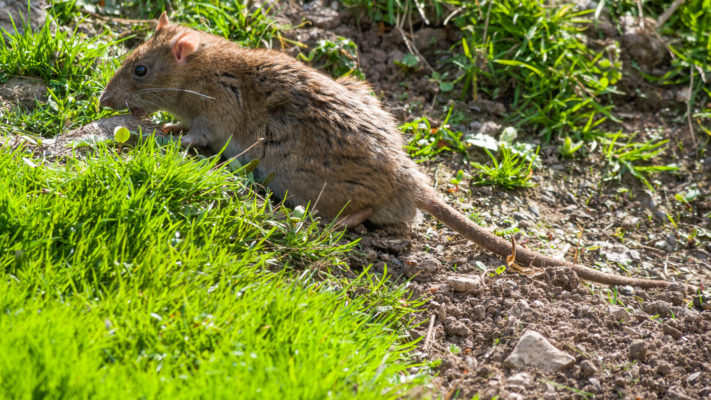Anticoagulant poisons are commonly used to kill rats in New Zealand and around the world. But at least 18 countries in Europe, America and Asia have reported growing resistance in their rat populations to these poisons. Are our rats growing bait-resistant too? Phil Cowan et al from Landcare Research investigated.

“Rats, except kiore, are currently widely distributed in urban areas, on farmland, in forest and native grasslands and on offshore islands. Unlike in Europe and North America, ship rats rather than Norway rats now predominate in most habitats. Because of the scale of New Zealand’s introduced rat problems and the magnitude of their impact, rats are controlled both intensively and extensively.”
Currently we rely heavily on anticoagulants for that rat control.
“The use of anticoagulants for rat control is currently widespread in New Zealand. Wax blocks or cereal-based baits containing anticoagulants are commonly used in bait stations both by official agencies such as the Department of Conservation and by regional councils, and many rat control products containing anticoagulants are available off the shelf in supermarkets and hardware stores.”
That widespread reliance could be encouraging the development of resistance to the toxins.
“This extensive domestic and field use of anticoagulants has resulted in widespread contamination of non-target native and introduced wildlife, suggesting the possibility that anticoagulant use patterns in New Zealand may have promoted the development of resistance in rodent populations not only in urban and farming areas but also in native habitats.”
Possible resistance to anticoagulants was reported in New Zealand as early as 1978.

“In 1978, anticoagulant resistance in rats was suggested in parts of Auckland city and on Raoul Island. These were not investigated, and rats were subsequently eradicated from Raoul Island in 2002 by aerial poisoning with cereal pellet baits containing brodifacoum. The present study was therefore undertaken to assess the status of anticoagulant resistance in New Zealand rats.”
So how do rats get to be resistant? One source of resistance is variations in a gene known as Vkorc1. This gene produces enzymes involved in Vitamin K metabolism.
“For example, the Vkorc1 polymorphism Tyr139Cys in Norway rats and house mice is known to increase resistance to the anticoagulants warfarin, coumatetralyl, bromadiolone and difenacoum, which have been or are used in New Zealand. Genetic screening methods for such mutations are well established and were used as the approach of choice in this study. However, resistance is not always associated with Vkorc1 mutations.”
The researchers sampled rat populations from a range of habitats throughout New Zealand, including offshore islands.
“Rodent samples (1–2 cm pieces of the distal end of tails) were collected between 2010 and 2012 by pest control staff of the Department of Conservation and regional councils, private pest control companies, other researchers and individuals involved with rodent control in a wide range of public conservation initiatives. Tail samples were immersed in Longmire buffer23 in individually numbered vials and stored at room temperature until analysis by EcoGene®.”
All three species of rats were sampled.
“Ship rats were the most commonly sampled and sequenced rat species both numerically and geographically (n=482; 29 out of 30 sites sampled), Norway rats were next most common (n=118; 15 out of 30 sites) and kiore were sampled only from two offshore island sites, Great Barrier Island (n=18) and Stewart Island (n=13).”
The researchers then looked for variations in the VKorc1 gene in each of their tail samples.
“Resistance is often associated with single nucleotide polymorphisms (SNPs) in the Vkorc1 gene. This study gives a first overview of the distribution and frequency of Vkorc1 SNPs in rats in New Zealand.”
Some of the SNPs found were different to gene sequence variations identified elsewhere in the world.
“Sequence variants occurred in at least one species of rat at all 30 of the sites sampled. Three new SNPs were identified, one in kiore and two in ship rats. No SNPs previously associated with resistance were found in Norway rats or kiore, but seven ship rats were heterozygous and one homozygous for the A74T variant. Its resultant Tyr25Phe mutation has previously been associated with resistance to both first- and second-generation anticoagulants in ship rats in Spain.”
So potential for anticoagulant resistance does exist in our ship rat population. The newly discovered SNPs could also potentially have resistance-conferring benefits for Norway and kiore rats, but that has yet to be tested.
“This is the first evidence of potential resistance to anticoagulant toxins in rats in New Zealand. Further testing using blood clotting response times in dosed rats is needed to confirm resistance potentially conferred by the Tyr25Phe mutation. Assessment is also needed of the potential of the other non-synonymous variants (Ala14Val, Ala26Val) recorded in this study to confer resistance to anticoagulant toxins.”
The full research paper is published in Pest Management Science and is freely available online.
Vkorc1 sequencing suggests anticoagulant resistance in rats in New Zealand (2016)

